Analysis of Google's Organisational Culture Using Schein's Model
VerifiedAdded on 2023/06/03
|17
|5064
|61
Report
AI Summary
This report provides an in-depth analysis of Google's organisational culture, focusing on its innovative environment and the values that drive its operations. It begins with a brief background of Google, highlighting its mission and global presence. The report then introduces the concept of organisational culture and discusses different frameworks, including Hofstede's and Schein's models. Schein's framework is chosen as the primary tool for analysis, and the report delves into the artefacts, espoused values, and basic assumptions that define Google's culture. The analysis covers aspects such as Google's 'work hard, play hard' atmosphere, its emphasis on innovation through the Think 10x concept, and its commitment to collaboration and data-driven decision-making. The report concludes by summarizing the key elements of Google's organisational culture as revealed through Schein's framework. Desklib provides students access to this and many other solved assignments.
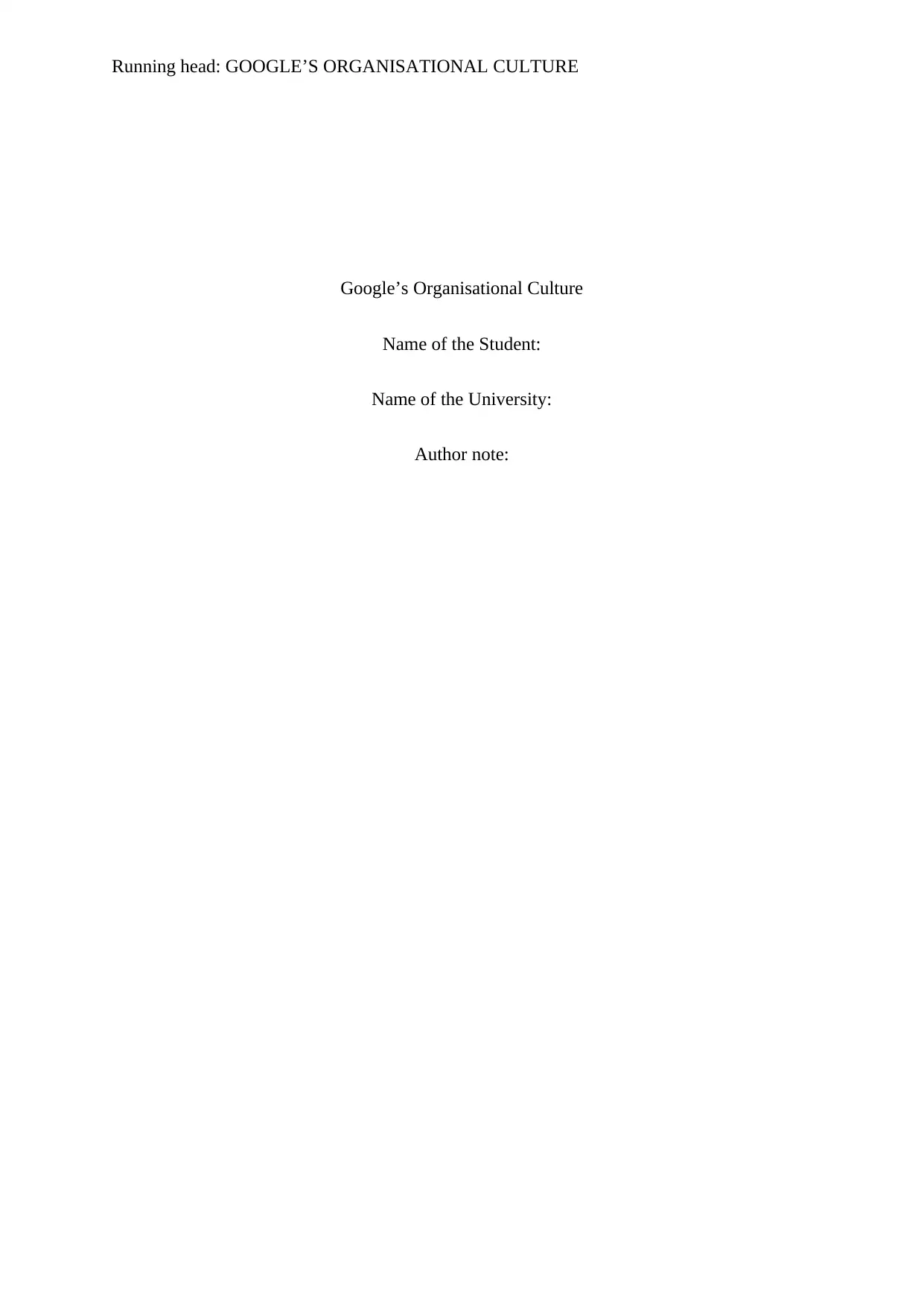
Running head: GOOGLE’S ORGANISATIONAL CULTURE
Google’s Organisational Culture
Name of the Student:
Name of the University:
Author note:
Google’s Organisational Culture
Name of the Student:
Name of the University:
Author note:
Paraphrase This Document
Need a fresh take? Get an instant paraphrase of this document with our AI Paraphraser
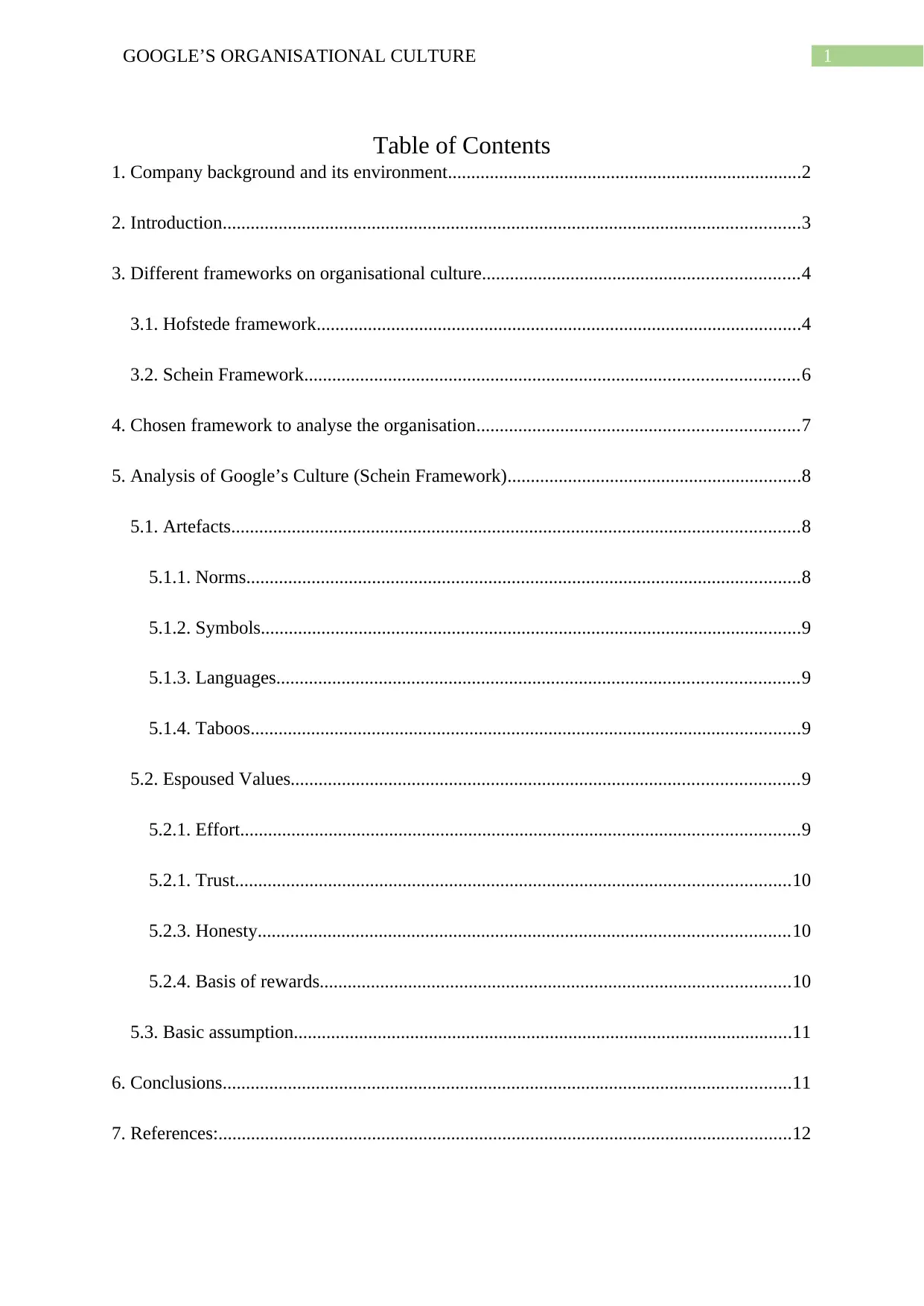
1GOOGLE’S ORGANISATIONAL CULTURE
Table of Contents
1. Company background and its environment............................................................................2
2. Introduction............................................................................................................................3
3. Different frameworks on organisational culture....................................................................4
3.1. Hofstede framework........................................................................................................4
3.2. Schein Framework..........................................................................................................6
4. Chosen framework to analyse the organisation.....................................................................7
5. Analysis of Google’s Culture (Schein Framework)...............................................................8
5.1. Artefacts..........................................................................................................................8
5.1.1. Norms.......................................................................................................................8
5.1.2. Symbols....................................................................................................................9
5.1.3. Languages................................................................................................................9
5.1.4. Taboos......................................................................................................................9
5.2. Espoused Values.............................................................................................................9
5.2.1. Effort........................................................................................................................9
5.2.1. Trust.......................................................................................................................10
5.2.3. Honesty..................................................................................................................10
5.2.4. Basis of rewards.....................................................................................................10
5.3. Basic assumption...........................................................................................................11
6. Conclusions..........................................................................................................................11
7. References:...........................................................................................................................12
Table of Contents
1. Company background and its environment............................................................................2
2. Introduction............................................................................................................................3
3. Different frameworks on organisational culture....................................................................4
3.1. Hofstede framework........................................................................................................4
3.2. Schein Framework..........................................................................................................6
4. Chosen framework to analyse the organisation.....................................................................7
5. Analysis of Google’s Culture (Schein Framework)...............................................................8
5.1. Artefacts..........................................................................................................................8
5.1.1. Norms.......................................................................................................................8
5.1.2. Symbols....................................................................................................................9
5.1.3. Languages................................................................................................................9
5.1.4. Taboos......................................................................................................................9
5.2. Espoused Values.............................................................................................................9
5.2.1. Effort........................................................................................................................9
5.2.1. Trust.......................................................................................................................10
5.2.3. Honesty..................................................................................................................10
5.2.4. Basis of rewards.....................................................................................................10
5.3. Basic assumption...........................................................................................................11
6. Conclusions..........................................................................................................................11
7. References:...........................................................................................................................12
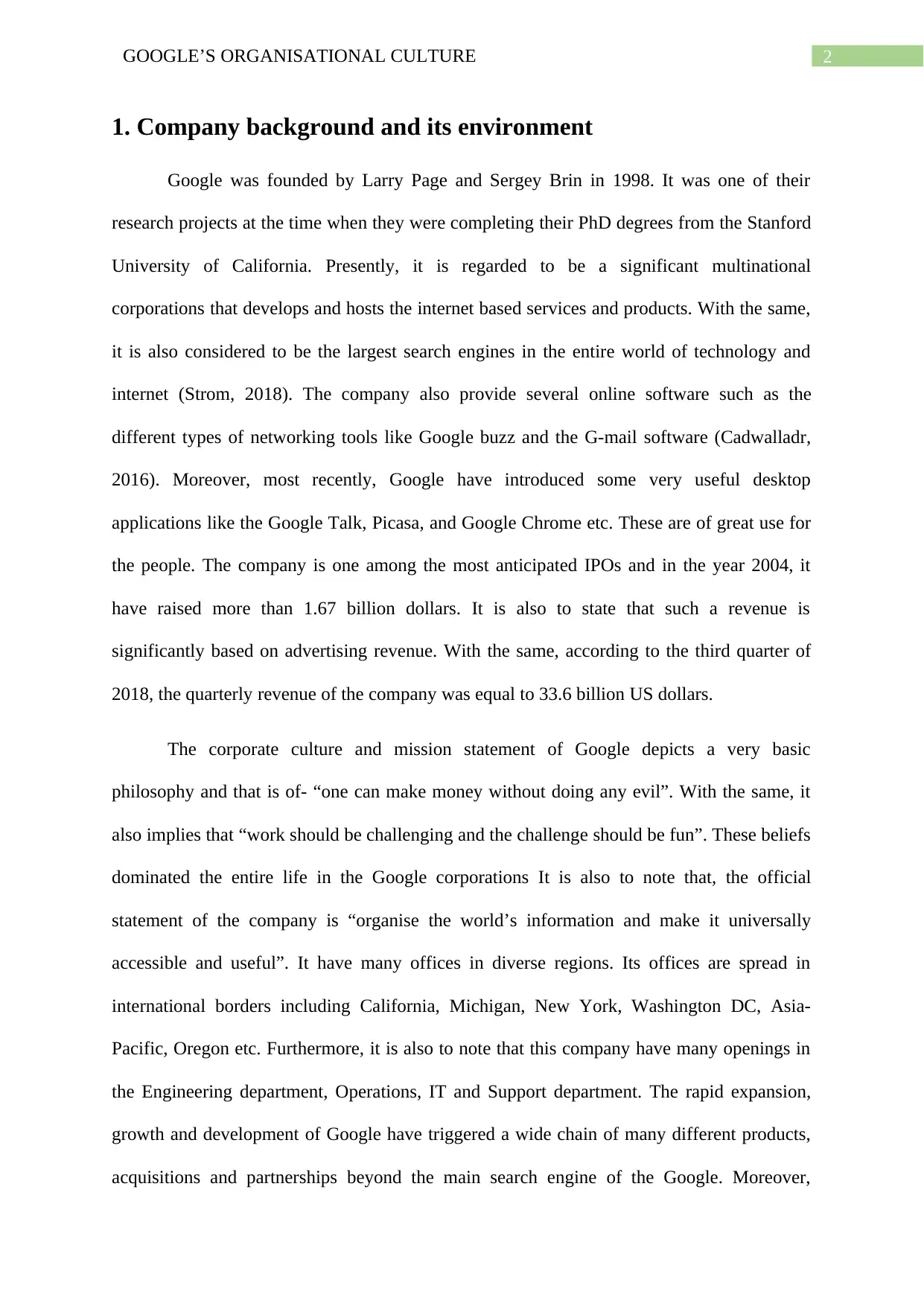
2GOOGLE’S ORGANISATIONAL CULTURE
1. Company background and its environment
Google was founded by Larry Page and Sergey Brin in 1998. It was one of their
research projects at the time when they were completing their PhD degrees from the Stanford
University of California. Presently, it is regarded to be a significant multinational
corporations that develops and hosts the internet based services and products. With the same,
it is also considered to be the largest search engines in the entire world of technology and
internet (Strom, 2018). The company also provide several online software such as the
different types of networking tools like Google buzz and the G-mail software (Cadwalladr,
2016). Moreover, most recently, Google have introduced some very useful desktop
applications like the Google Talk, Picasa, and Google Chrome etc. These are of great use for
the people. The company is one among the most anticipated IPOs and in the year 2004, it
have raised more than 1.67 billion dollars. It is also to state that such a revenue is
significantly based on advertising revenue. With the same, according to the third quarter of
2018, the quarterly revenue of the company was equal to 33.6 billion US dollars.
The corporate culture and mission statement of Google depicts a very basic
philosophy and that is of- “one can make money without doing any evil”. With the same, it
also implies that “work should be challenging and the challenge should be fun”. These beliefs
dominated the entire life in the Google corporations It is also to note that, the official
statement of the company is “organise the world’s information and make it universally
accessible and useful”. It have many offices in diverse regions. Its offices are spread in
international borders including California, Michigan, New York, Washington DC, Asia-
Pacific, Oregon etc. Furthermore, it is also to note that this company have many openings in
the Engineering department, Operations, IT and Support department. The rapid expansion,
growth and development of Google have triggered a wide chain of many different products,
acquisitions and partnerships beyond the main search engine of the Google. Moreover,
1. Company background and its environment
Google was founded by Larry Page and Sergey Brin in 1998. It was one of their
research projects at the time when they were completing their PhD degrees from the Stanford
University of California. Presently, it is regarded to be a significant multinational
corporations that develops and hosts the internet based services and products. With the same,
it is also considered to be the largest search engines in the entire world of technology and
internet (Strom, 2018). The company also provide several online software such as the
different types of networking tools like Google buzz and the G-mail software (Cadwalladr,
2016). Moreover, most recently, Google have introduced some very useful desktop
applications like the Google Talk, Picasa, and Google Chrome etc. These are of great use for
the people. The company is one among the most anticipated IPOs and in the year 2004, it
have raised more than 1.67 billion dollars. It is also to state that such a revenue is
significantly based on advertising revenue. With the same, according to the third quarter of
2018, the quarterly revenue of the company was equal to 33.6 billion US dollars.
The corporate culture and mission statement of Google depicts a very basic
philosophy and that is of- “one can make money without doing any evil”. With the same, it
also implies that “work should be challenging and the challenge should be fun”. These beliefs
dominated the entire life in the Google corporations It is also to note that, the official
statement of the company is “organise the world’s information and make it universally
accessible and useful”. It have many offices in diverse regions. Its offices are spread in
international borders including California, Michigan, New York, Washington DC, Asia-
Pacific, Oregon etc. Furthermore, it is also to note that this company have many openings in
the Engineering department, Operations, IT and Support department. The rapid expansion,
growth and development of Google have triggered a wide chain of many different products,
acquisitions and partnerships beyond the main search engine of the Google. Moreover,
⊘ This is a preview!⊘
Do you want full access?
Subscribe today to unlock all pages.

Trusted by 1+ million students worldwide
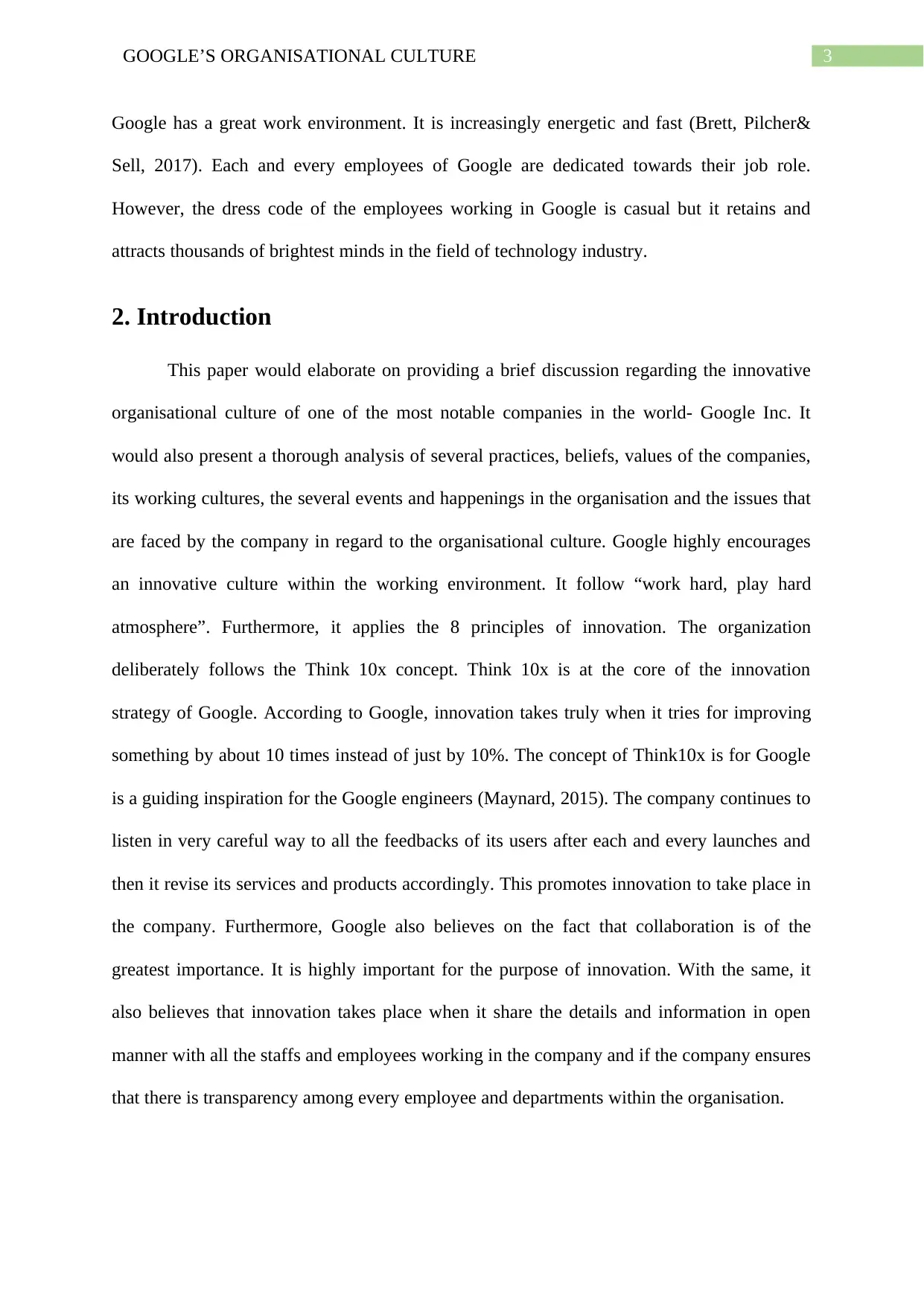
3GOOGLE’S ORGANISATIONAL CULTURE
Google has a great work environment. It is increasingly energetic and fast (Brett, Pilcher&
Sell, 2017). Each and every employees of Google are dedicated towards their job role.
However, the dress code of the employees working in Google is casual but it retains and
attracts thousands of brightest minds in the field of technology industry.
2. Introduction
This paper would elaborate on providing a brief discussion regarding the innovative
organisational culture of one of the most notable companies in the world- Google Inc. It
would also present a thorough analysis of several practices, beliefs, values of the companies,
its working cultures, the several events and happenings in the organisation and the issues that
are faced by the company in regard to the organisational culture. Google highly encourages
an innovative culture within the working environment. It follow “work hard, play hard
atmosphere”. Furthermore, it applies the 8 principles of innovation. The organization
deliberately follows the Think 10x concept. Think 10x is at the core of the innovation
strategy of Google. According to Google, innovation takes truly when it tries for improving
something by about 10 times instead of just by 10%. The concept of Think10x is for Google
is a guiding inspiration for the Google engineers (Maynard, 2015). The company continues to
listen in very careful way to all the feedbacks of its users after each and every launches and
then it revise its services and products accordingly. This promotes innovation to take place in
the company. Furthermore, Google also believes on the fact that collaboration is of the
greatest importance. It is highly important for the purpose of innovation. With the same, it
also believes that innovation takes place when it share the details and information in open
manner with all the staffs and employees working in the company and if the company ensures
that there is transparency among every employee and departments within the organisation.
Google has a great work environment. It is increasingly energetic and fast (Brett, Pilcher&
Sell, 2017). Each and every employees of Google are dedicated towards their job role.
However, the dress code of the employees working in Google is casual but it retains and
attracts thousands of brightest minds in the field of technology industry.
2. Introduction
This paper would elaborate on providing a brief discussion regarding the innovative
organisational culture of one of the most notable companies in the world- Google Inc. It
would also present a thorough analysis of several practices, beliefs, values of the companies,
its working cultures, the several events and happenings in the organisation and the issues that
are faced by the company in regard to the organisational culture. Google highly encourages
an innovative culture within the working environment. It follow “work hard, play hard
atmosphere”. Furthermore, it applies the 8 principles of innovation. The organization
deliberately follows the Think 10x concept. Think 10x is at the core of the innovation
strategy of Google. According to Google, innovation takes truly when it tries for improving
something by about 10 times instead of just by 10%. The concept of Think10x is for Google
is a guiding inspiration for the Google engineers (Maynard, 2015). The company continues to
listen in very careful way to all the feedbacks of its users after each and every launches and
then it revise its services and products accordingly. This promotes innovation to take place in
the company. Furthermore, Google also believes on the fact that collaboration is of the
greatest importance. It is highly important for the purpose of innovation. With the same, it
also believes that innovation takes place when it share the details and information in open
manner with all the staffs and employees working in the company and if the company ensures
that there is transparency among every employee and departments within the organisation.
Paraphrase This Document
Need a fresh take? Get an instant paraphrase of this document with our AI Paraphraser
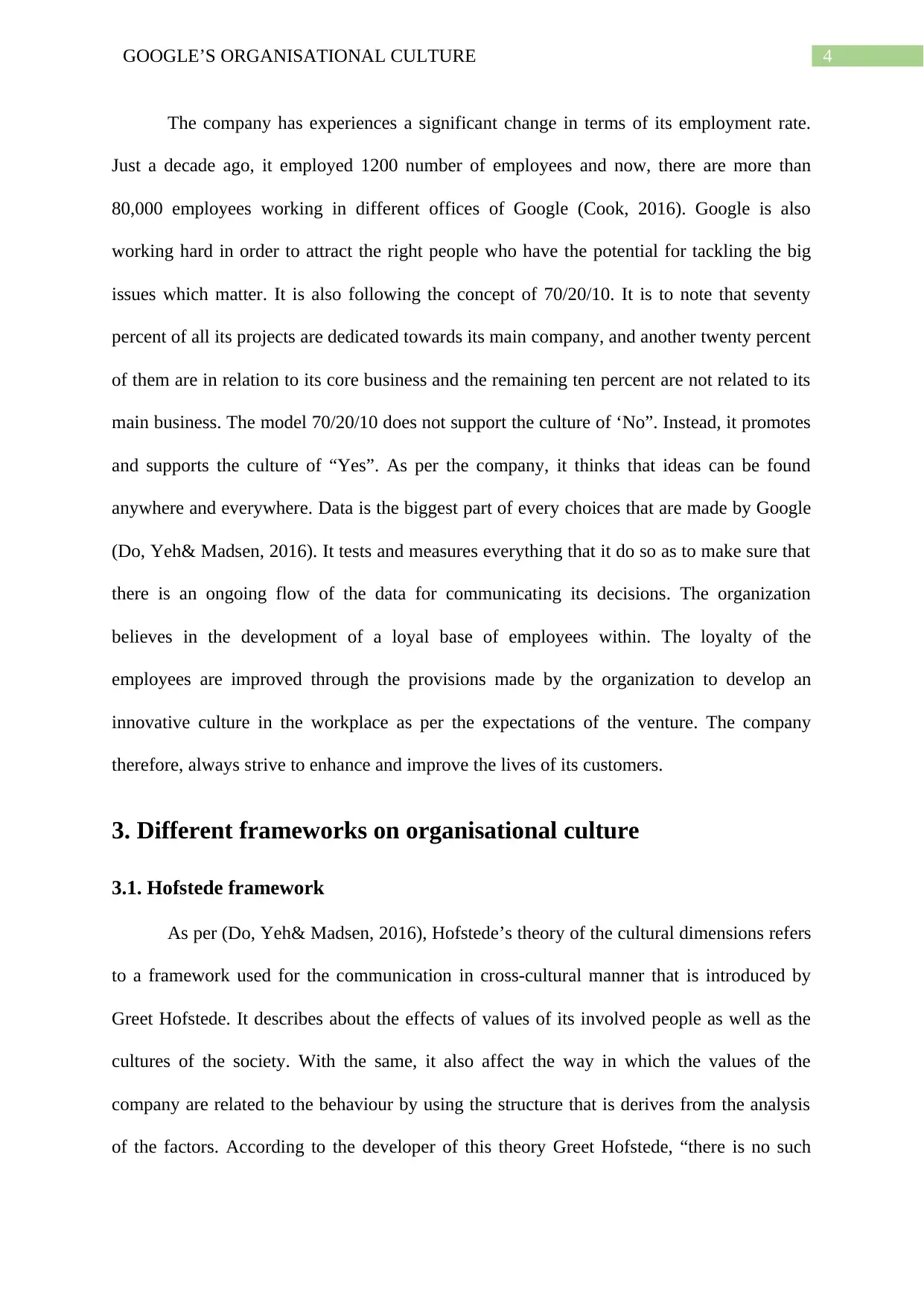
4GOOGLE’S ORGANISATIONAL CULTURE
The company has experiences a significant change in terms of its employment rate.
Just a decade ago, it employed 1200 number of employees and now, there are more than
80,000 employees working in different offices of Google (Cook, 2016). Google is also
working hard in order to attract the right people who have the potential for tackling the big
issues which matter. It is also following the concept of 70/20/10. It is to note that seventy
percent of all its projects are dedicated towards its main company, and another twenty percent
of them are in relation to its core business and the remaining ten percent are not related to its
main business. The model 70/20/10 does not support the culture of ‘No”. Instead, it promotes
and supports the culture of “Yes”. As per the company, it thinks that ideas can be found
anywhere and everywhere. Data is the biggest part of every choices that are made by Google
(Do, Yeh& Madsen, 2016). It tests and measures everything that it do so as to make sure that
there is an ongoing flow of the data for communicating its decisions. The organization
believes in the development of a loyal base of employees within. The loyalty of the
employees are improved through the provisions made by the organization to develop an
innovative culture in the workplace as per the expectations of the venture. The company
therefore, always strive to enhance and improve the lives of its customers.
3. Different frameworks on organisational culture
3.1. Hofstede framework
As per (Do, Yeh& Madsen, 2016), Hofstede’s theory of the cultural dimensions refers
to a framework used for the communication in cross-cultural manner that is introduced by
Greet Hofstede. It describes about the effects of values of its involved people as well as the
cultures of the society. With the same, it also affect the way in which the values of the
company are related to the behaviour by using the structure that is derives from the analysis
of the factors. According to the developer of this theory Greet Hofstede, “there is no such
The company has experiences a significant change in terms of its employment rate.
Just a decade ago, it employed 1200 number of employees and now, there are more than
80,000 employees working in different offices of Google (Cook, 2016). Google is also
working hard in order to attract the right people who have the potential for tackling the big
issues which matter. It is also following the concept of 70/20/10. It is to note that seventy
percent of all its projects are dedicated towards its main company, and another twenty percent
of them are in relation to its core business and the remaining ten percent are not related to its
main business. The model 70/20/10 does not support the culture of ‘No”. Instead, it promotes
and supports the culture of “Yes”. As per the company, it thinks that ideas can be found
anywhere and everywhere. Data is the biggest part of every choices that are made by Google
(Do, Yeh& Madsen, 2016). It tests and measures everything that it do so as to make sure that
there is an ongoing flow of the data for communicating its decisions. The organization
believes in the development of a loyal base of employees within. The loyalty of the
employees are improved through the provisions made by the organization to develop an
innovative culture in the workplace as per the expectations of the venture. The company
therefore, always strive to enhance and improve the lives of its customers.
3. Different frameworks on organisational culture
3.1. Hofstede framework
As per (Do, Yeh& Madsen, 2016), Hofstede’s theory of the cultural dimensions refers
to a framework used for the communication in cross-cultural manner that is introduced by
Greet Hofstede. It describes about the effects of values of its involved people as well as the
cultures of the society. With the same, it also affect the way in which the values of the
company are related to the behaviour by using the structure that is derives from the analysis
of the factors. According to the developer of this theory Greet Hofstede, “there is no such
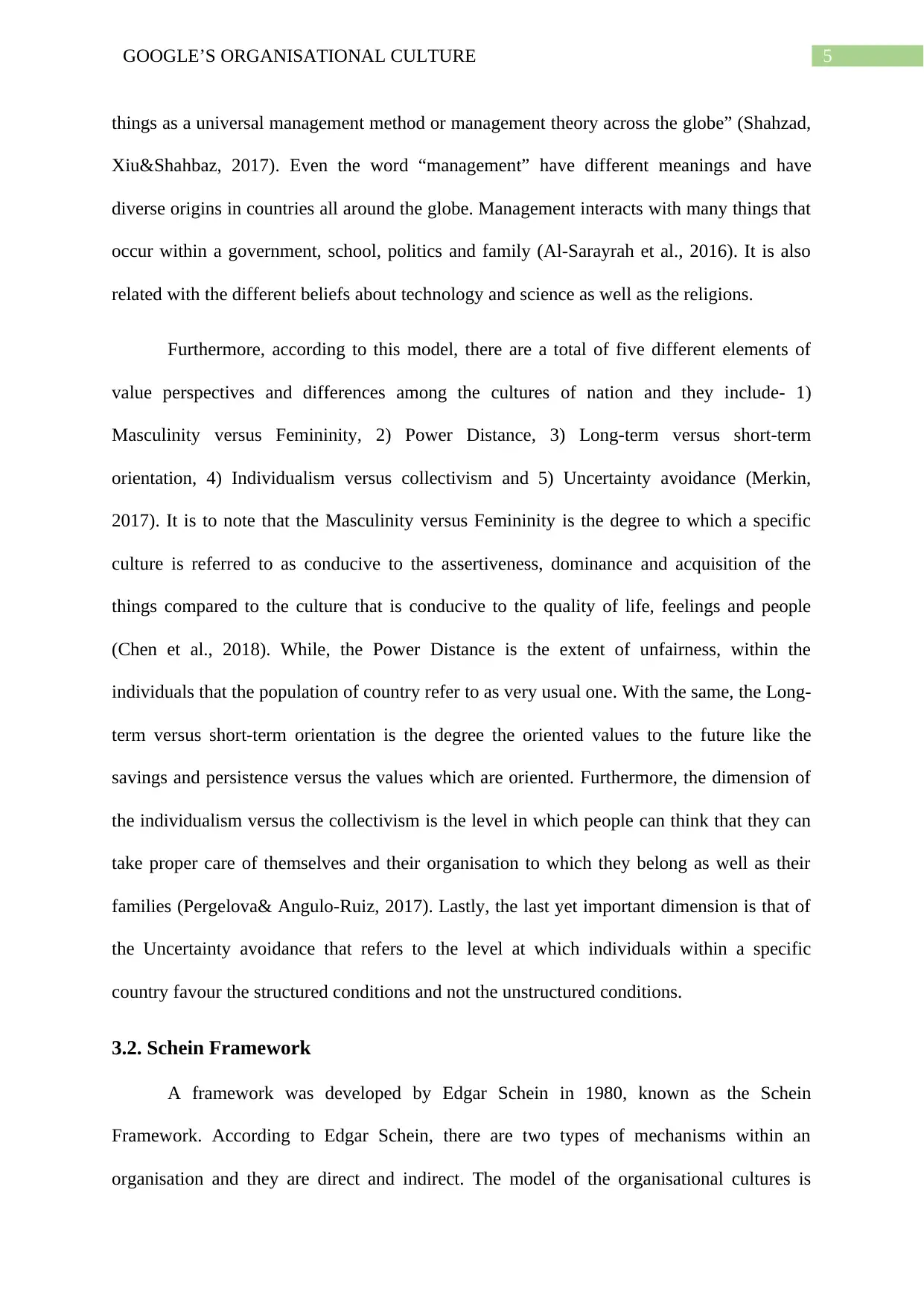
5GOOGLE’S ORGANISATIONAL CULTURE
things as a universal management method or management theory across the globe” (Shahzad,
Xiu&Shahbaz, 2017). Even the word “management” have different meanings and have
diverse origins in countries all around the globe. Management interacts with many things that
occur within a government, school, politics and family (Al-Sarayrah et al., 2016). It is also
related with the different beliefs about technology and science as well as the religions.
Furthermore, according to this model, there are a total of five different elements of
value perspectives and differences among the cultures of nation and they include- 1)
Masculinity versus Femininity, 2) Power Distance, 3) Long-term versus short-term
orientation, 4) Individualism versus collectivism and 5) Uncertainty avoidance (Merkin,
2017). It is to note that the Masculinity versus Femininity is the degree to which a specific
culture is referred to as conducive to the assertiveness, dominance and acquisition of the
things compared to the culture that is conducive to the quality of life, feelings and people
(Chen et al., 2018). While, the Power Distance is the extent of unfairness, within the
individuals that the population of country refer to as very usual one. With the same, the Long-
term versus short-term orientation is the degree the oriented values to the future like the
savings and persistence versus the values which are oriented. Furthermore, the dimension of
the individualism versus the collectivism is the level in which people can think that they can
take proper care of themselves and their organisation to which they belong as well as their
families (Pergelova& Angulo-Ruiz, 2017). Lastly, the last yet important dimension is that of
the Uncertainty avoidance that refers to the level at which individuals within a specific
country favour the structured conditions and not the unstructured conditions.
3.2. Schein Framework
A framework was developed by Edgar Schein in 1980, known as the Schein
Framework. According to Edgar Schein, there are two types of mechanisms within an
organisation and they are direct and indirect. The model of the organisational cultures is
things as a universal management method or management theory across the globe” (Shahzad,
Xiu&Shahbaz, 2017). Even the word “management” have different meanings and have
diverse origins in countries all around the globe. Management interacts with many things that
occur within a government, school, politics and family (Al-Sarayrah et al., 2016). It is also
related with the different beliefs about technology and science as well as the religions.
Furthermore, according to this model, there are a total of five different elements of
value perspectives and differences among the cultures of nation and they include- 1)
Masculinity versus Femininity, 2) Power Distance, 3) Long-term versus short-term
orientation, 4) Individualism versus collectivism and 5) Uncertainty avoidance (Merkin,
2017). It is to note that the Masculinity versus Femininity is the degree to which a specific
culture is referred to as conducive to the assertiveness, dominance and acquisition of the
things compared to the culture that is conducive to the quality of life, feelings and people
(Chen et al., 2018). While, the Power Distance is the extent of unfairness, within the
individuals that the population of country refer to as very usual one. With the same, the Long-
term versus short-term orientation is the degree the oriented values to the future like the
savings and persistence versus the values which are oriented. Furthermore, the dimension of
the individualism versus the collectivism is the level in which people can think that they can
take proper care of themselves and their organisation to which they belong as well as their
families (Pergelova& Angulo-Ruiz, 2017). Lastly, the last yet important dimension is that of
the Uncertainty avoidance that refers to the level at which individuals within a specific
country favour the structured conditions and not the unstructured conditions.
3.2. Schein Framework
A framework was developed by Edgar Schein in 1980, known as the Schein
Framework. According to Edgar Schein, there are two types of mechanisms within an
organisation and they are direct and indirect. The model of the organisational cultures is
⊘ This is a preview!⊘
Do you want full access?
Subscribe today to unlock all pages.

Trusted by 1+ million students worldwide
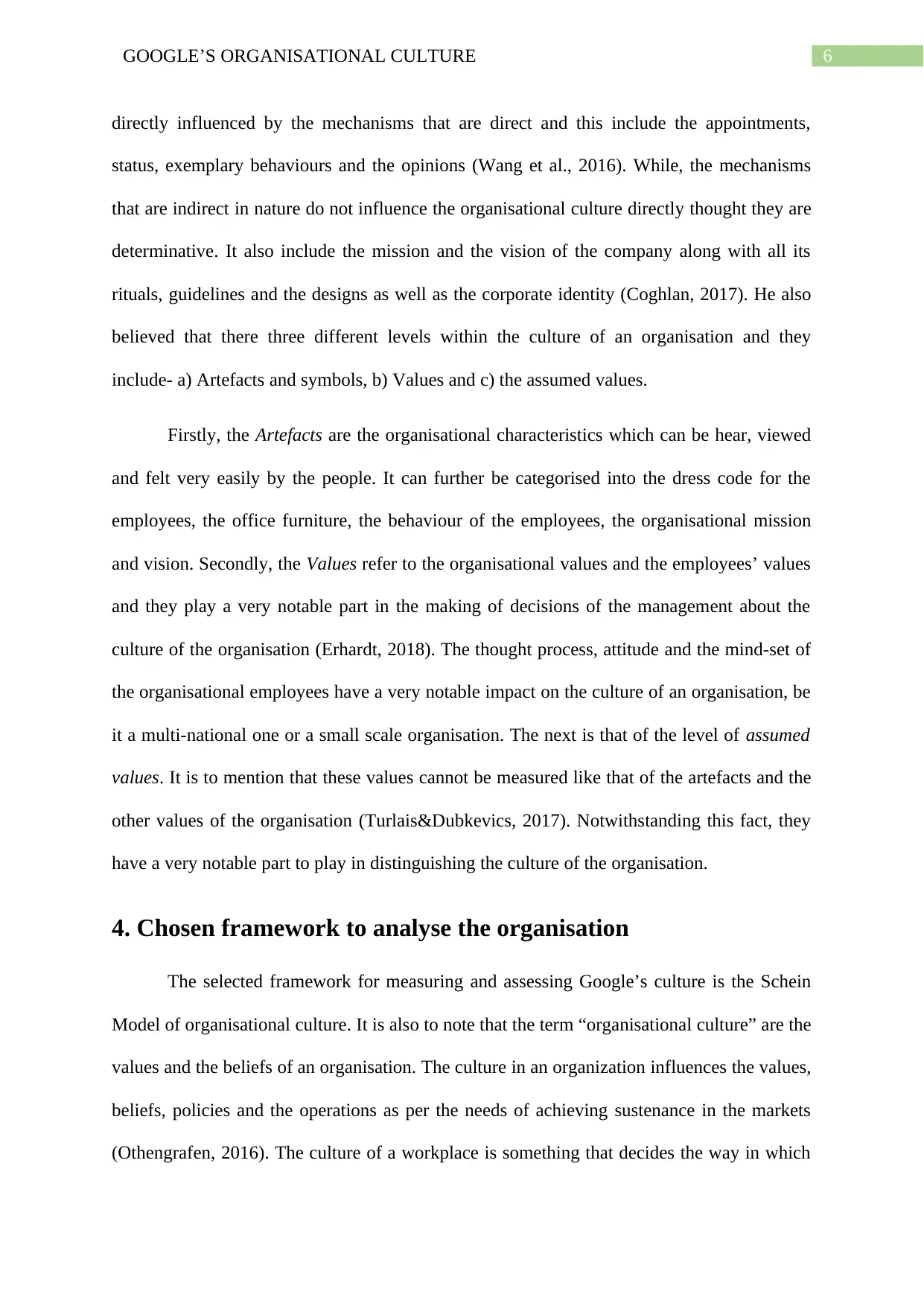
6GOOGLE’S ORGANISATIONAL CULTURE
directly influenced by the mechanisms that are direct and this include the appointments,
status, exemplary behaviours and the opinions (Wang et al., 2016). While, the mechanisms
that are indirect in nature do not influence the organisational culture directly thought they are
determinative. It also include the mission and the vision of the company along with all its
rituals, guidelines and the designs as well as the corporate identity (Coghlan, 2017). He also
believed that there three different levels within the culture of an organisation and they
include- a) Artefacts and symbols, b) Values and c) the assumed values.
Firstly, the Artefacts are the organisational characteristics which can be hear, viewed
and felt very easily by the people. It can further be categorised into the dress code for the
employees, the office furniture, the behaviour of the employees, the organisational mission
and vision. Secondly, the Values refer to the organisational values and the employees’ values
and they play a very notable part in the making of decisions of the management about the
culture of the organisation (Erhardt, 2018). The thought process, attitude and the mind-set of
the organisational employees have a very notable impact on the culture of an organisation, be
it a multi-national one or a small scale organisation. The next is that of the level of assumed
values. It is to mention that these values cannot be measured like that of the artefacts and the
other values of the organisation (Turlais&Dubkevics, 2017). Notwithstanding this fact, they
have a very notable part to play in distinguishing the culture of the organisation.
4. Chosen framework to analyse the organisation
The selected framework for measuring and assessing Google’s culture is the Schein
Model of organisational culture. It is also to note that the term “organisational culture” are the
values and the beliefs of an organisation. The culture in an organization influences the values,
beliefs, policies and the operations as per the needs of achieving sustenance in the markets
(Othengrafen, 2016). The culture of a workplace is something that decides the way in which
directly influenced by the mechanisms that are direct and this include the appointments,
status, exemplary behaviours and the opinions (Wang et al., 2016). While, the mechanisms
that are indirect in nature do not influence the organisational culture directly thought they are
determinative. It also include the mission and the vision of the company along with all its
rituals, guidelines and the designs as well as the corporate identity (Coghlan, 2017). He also
believed that there three different levels within the culture of an organisation and they
include- a) Artefacts and symbols, b) Values and c) the assumed values.
Firstly, the Artefacts are the organisational characteristics which can be hear, viewed
and felt very easily by the people. It can further be categorised into the dress code for the
employees, the office furniture, the behaviour of the employees, the organisational mission
and vision. Secondly, the Values refer to the organisational values and the employees’ values
and they play a very notable part in the making of decisions of the management about the
culture of the organisation (Erhardt, 2018). The thought process, attitude and the mind-set of
the organisational employees have a very notable impact on the culture of an organisation, be
it a multi-national one or a small scale organisation. The next is that of the level of assumed
values. It is to mention that these values cannot be measured like that of the artefacts and the
other values of the organisation (Turlais&Dubkevics, 2017). Notwithstanding this fact, they
have a very notable part to play in distinguishing the culture of the organisation.
4. Chosen framework to analyse the organisation
The selected framework for measuring and assessing Google’s culture is the Schein
Model of organisational culture. It is also to note that the term “organisational culture” are the
values and the beliefs of an organisation. The culture in an organization influences the values,
beliefs, policies and the operations as per the needs of achieving sustenance in the markets
(Othengrafen, 2016). The culture of a workplace is something that decides the way in which
Paraphrase This Document
Need a fresh take? Get an instant paraphrase of this document with our AI Paraphraser
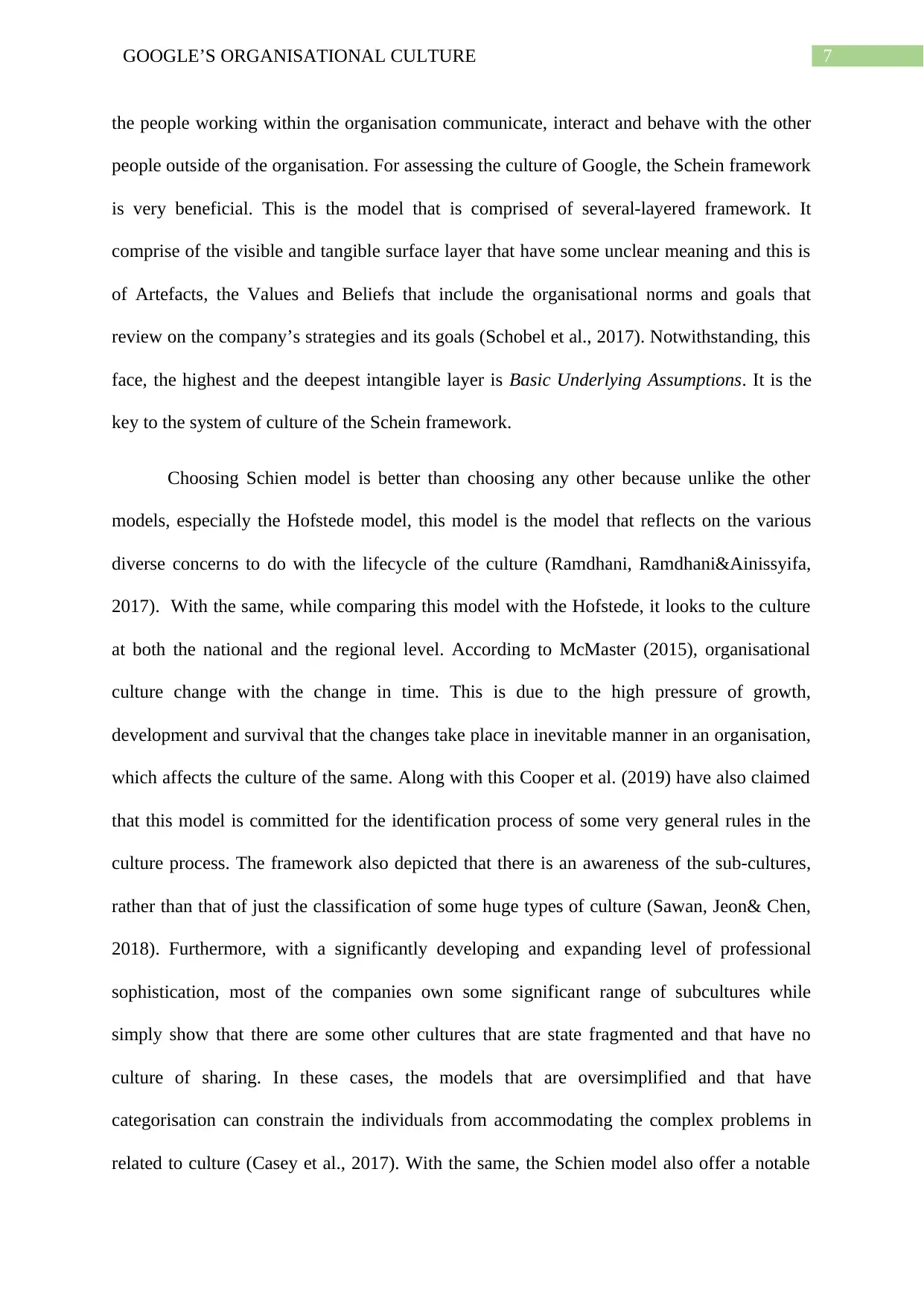
7GOOGLE’S ORGANISATIONAL CULTURE
the people working within the organisation communicate, interact and behave with the other
people outside of the organisation. For assessing the culture of Google, the Schein framework
is very beneficial. This is the model that is comprised of several-layered framework. It
comprise of the visible and tangible surface layer that have some unclear meaning and this is
of Artefacts, the Values and Beliefs that include the organisational norms and goals that
review on the company’s strategies and its goals (Schobel et al., 2017). Notwithstanding, this
face, the highest and the deepest intangible layer is Basic Underlying Assumptions. It is the
key to the system of culture of the Schein framework.
Choosing Schien model is better than choosing any other because unlike the other
models, especially the Hofstede model, this model is the model that reflects on the various
diverse concerns to do with the lifecycle of the culture (Ramdhani, Ramdhani&Ainissyifa,
2017). With the same, while comparing this model with the Hofstede, it looks to the culture
at both the national and the regional level. According to McMaster (2015), organisational
culture change with the change in time. This is due to the high pressure of growth,
development and survival that the changes take place in inevitable manner in an organisation,
which affects the culture of the same. Along with this Cooper et al. (2019) have also claimed
that this model is committed for the identification process of some very general rules in the
culture process. The framework also depicted that there is an awareness of the sub-cultures,
rather than that of just the classification of some huge types of culture (Sawan, Jeon& Chen,
2018). Furthermore, with a significantly developing and expanding level of professional
sophistication, most of the companies own some significant range of subcultures while
simply show that there are some other cultures that are state fragmented and that have no
culture of sharing. In these cases, the models that are oversimplified and that have
categorisation can constrain the individuals from accommodating the complex problems in
related to culture (Casey et al., 2017). With the same, the Schien model also offer a notable
the people working within the organisation communicate, interact and behave with the other
people outside of the organisation. For assessing the culture of Google, the Schein framework
is very beneficial. This is the model that is comprised of several-layered framework. It
comprise of the visible and tangible surface layer that have some unclear meaning and this is
of Artefacts, the Values and Beliefs that include the organisational norms and goals that
review on the company’s strategies and its goals (Schobel et al., 2017). Notwithstanding, this
face, the highest and the deepest intangible layer is Basic Underlying Assumptions. It is the
key to the system of culture of the Schein framework.
Choosing Schien model is better than choosing any other because unlike the other
models, especially the Hofstede model, this model is the model that reflects on the various
diverse concerns to do with the lifecycle of the culture (Ramdhani, Ramdhani&Ainissyifa,
2017). With the same, while comparing this model with the Hofstede, it looks to the culture
at both the national and the regional level. According to McMaster (2015), organisational
culture change with the change in time. This is due to the high pressure of growth,
development and survival that the changes take place in inevitable manner in an organisation,
which affects the culture of the same. Along with this Cooper et al. (2019) have also claimed
that this model is committed for the identification process of some very general rules in the
culture process. The framework also depicted that there is an awareness of the sub-cultures,
rather than that of just the classification of some huge types of culture (Sawan, Jeon& Chen,
2018). Furthermore, with a significantly developing and expanding level of professional
sophistication, most of the companies own some significant range of subcultures while
simply show that there are some other cultures that are state fragmented and that have no
culture of sharing. In these cases, the models that are oversimplified and that have
categorisation can constrain the individuals from accommodating the complex problems in
related to culture (Casey et al., 2017). With the same, the Schien model also offer a notable
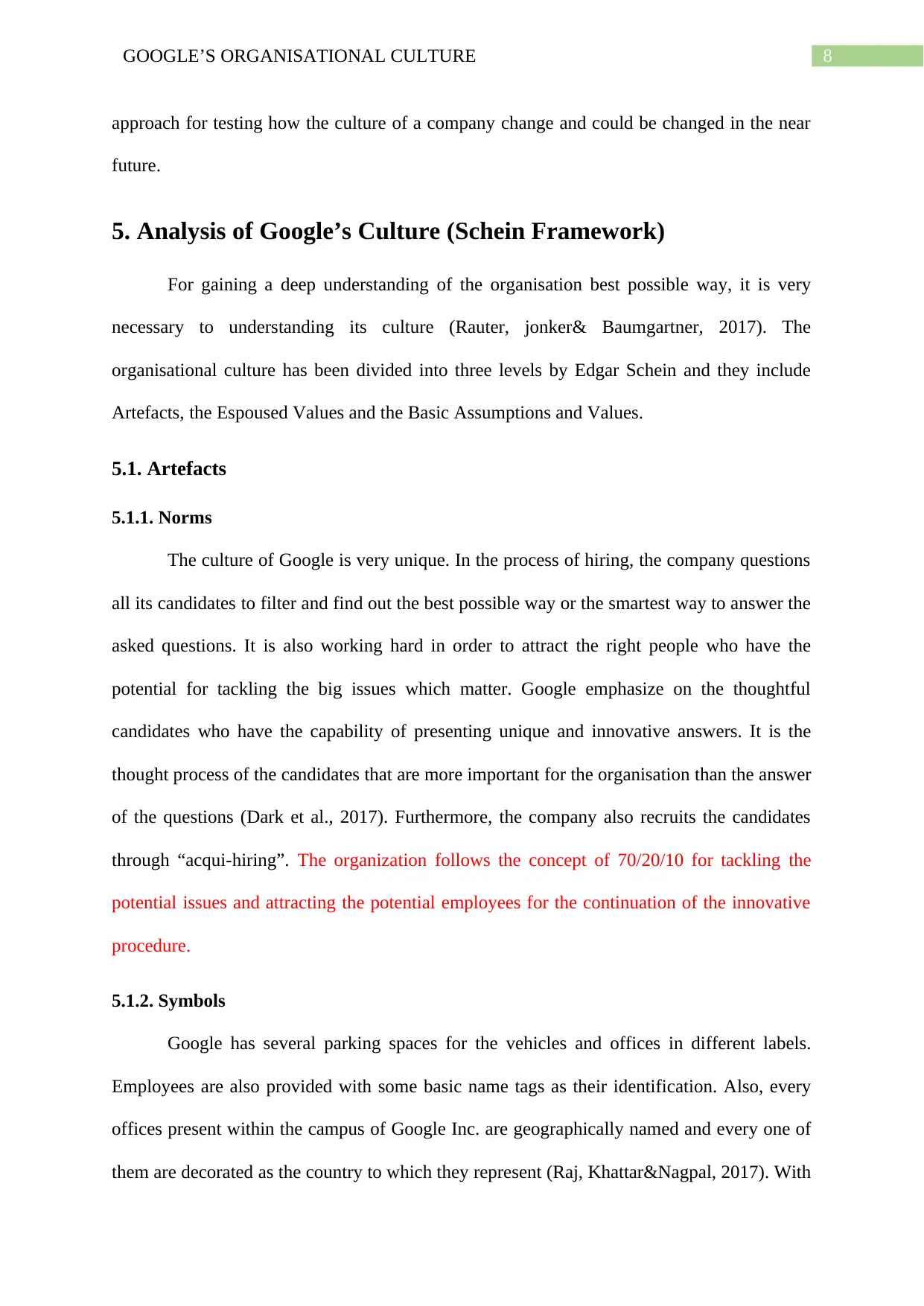
8GOOGLE’S ORGANISATIONAL CULTURE
approach for testing how the culture of a company change and could be changed in the near
future.
5. Analysis of Google’s Culture (Schein Framework)
For gaining a deep understanding of the organisation best possible way, it is very
necessary to understanding its culture (Rauter, jonker& Baumgartner, 2017). The
organisational culture has been divided into three levels by Edgar Schein and they include
Artefacts, the Espoused Values and the Basic Assumptions and Values.
5.1. Artefacts
5.1.1. Norms
The culture of Google is very unique. In the process of hiring, the company questions
all its candidates to filter and find out the best possible way or the smartest way to answer the
asked questions. It is also working hard in order to attract the right people who have the
potential for tackling the big issues which matter. Google emphasize on the thoughtful
candidates who have the capability of presenting unique and innovative answers. It is the
thought process of the candidates that are more important for the organisation than the answer
of the questions (Dark et al., 2017). Furthermore, the company also recruits the candidates
through “acqui-hiring”. The organization follows the concept of 70/20/10 for tackling the
potential issues and attracting the potential employees for the continuation of the innovative
procedure.
5.1.2. Symbols
Google has several parking spaces for the vehicles and offices in different labels.
Employees are also provided with some basic name tags as their identification. Also, every
offices present within the campus of Google Inc. are geographically named and every one of
them are decorated as the country to which they represent (Raj, Khattar&Nagpal, 2017). With
approach for testing how the culture of a company change and could be changed in the near
future.
5. Analysis of Google’s Culture (Schein Framework)
For gaining a deep understanding of the organisation best possible way, it is very
necessary to understanding its culture (Rauter, jonker& Baumgartner, 2017). The
organisational culture has been divided into three levels by Edgar Schein and they include
Artefacts, the Espoused Values and the Basic Assumptions and Values.
5.1. Artefacts
5.1.1. Norms
The culture of Google is very unique. In the process of hiring, the company questions
all its candidates to filter and find out the best possible way or the smartest way to answer the
asked questions. It is also working hard in order to attract the right people who have the
potential for tackling the big issues which matter. Google emphasize on the thoughtful
candidates who have the capability of presenting unique and innovative answers. It is the
thought process of the candidates that are more important for the organisation than the answer
of the questions (Dark et al., 2017). Furthermore, the company also recruits the candidates
through “acqui-hiring”. The organization follows the concept of 70/20/10 for tackling the
potential issues and attracting the potential employees for the continuation of the innovative
procedure.
5.1.2. Symbols
Google has several parking spaces for the vehicles and offices in different labels.
Employees are also provided with some basic name tags as their identification. Also, every
offices present within the campus of Google Inc. are geographically named and every one of
them are decorated as the country to which they represent (Raj, Khattar&Nagpal, 2017). With
⊘ This is a preview!⊘
Do you want full access?
Subscribe today to unlock all pages.

Trusted by 1+ million students worldwide
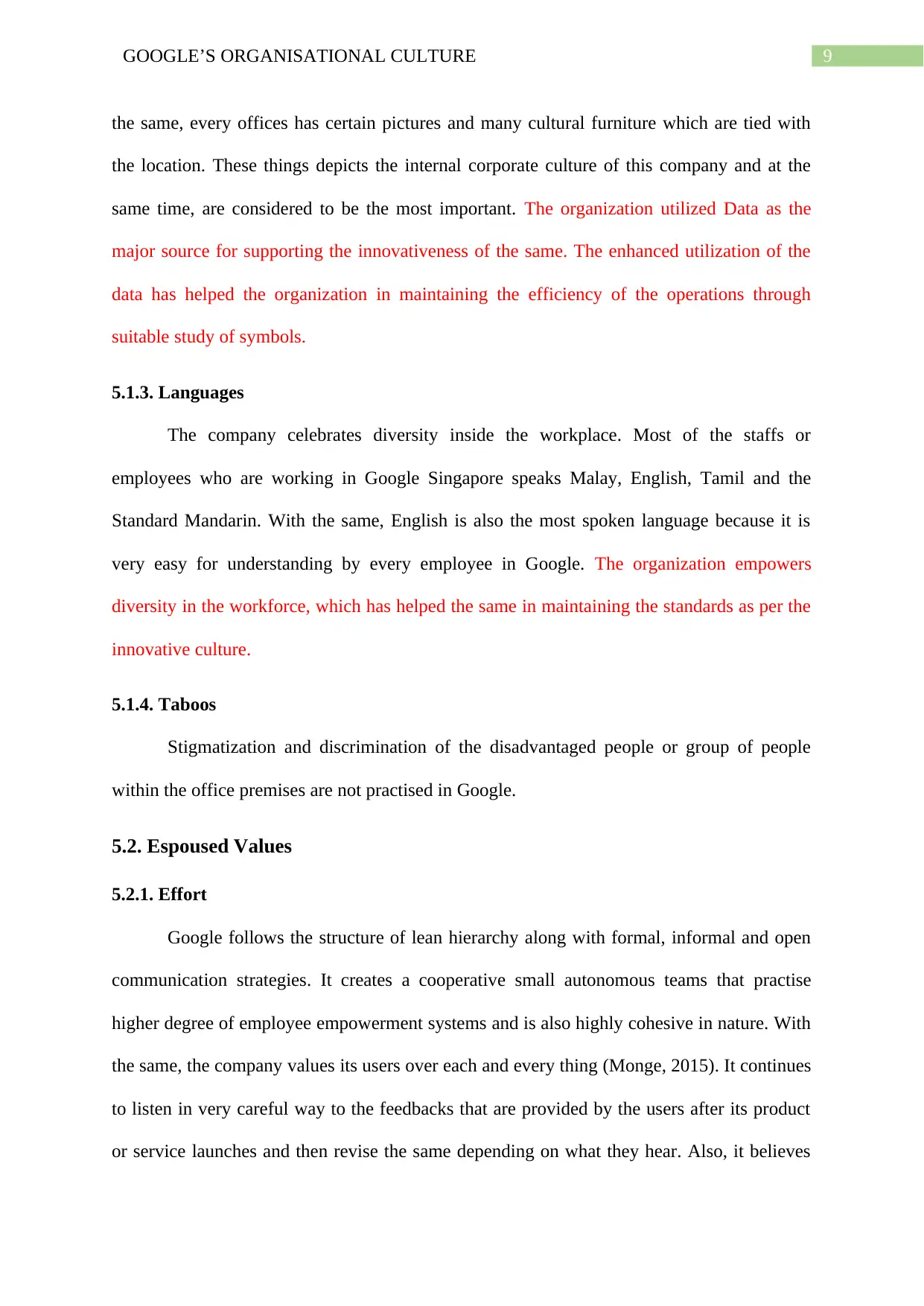
9GOOGLE’S ORGANISATIONAL CULTURE
the same, every offices has certain pictures and many cultural furniture which are tied with
the location. These things depicts the internal corporate culture of this company and at the
same time, are considered to be the most important. The organization utilized Data as the
major source for supporting the innovativeness of the same. The enhanced utilization of the
data has helped the organization in maintaining the efficiency of the operations through
suitable study of symbols.
5.1.3. Languages
The company celebrates diversity inside the workplace. Most of the staffs or
employees who are working in Google Singapore speaks Malay, English, Tamil and the
Standard Mandarin. With the same, English is also the most spoken language because it is
very easy for understanding by every employee in Google. The organization empowers
diversity in the workforce, which has helped the same in maintaining the standards as per the
innovative culture.
5.1.4. Taboos
Stigmatization and discrimination of the disadvantaged people or group of people
within the office premises are not practised in Google.
5.2. Espoused Values
5.2.1. Effort
Google follows the structure of lean hierarchy along with formal, informal and open
communication strategies. It creates a cooperative small autonomous teams that practise
higher degree of employee empowerment systems and is also highly cohesive in nature. With
the same, the company values its users over each and every thing (Monge, 2015). It continues
to listen in very careful way to the feedbacks that are provided by the users after its product
or service launches and then revise the same depending on what they hear. Also, it believes
the same, every offices has certain pictures and many cultural furniture which are tied with
the location. These things depicts the internal corporate culture of this company and at the
same time, are considered to be the most important. The organization utilized Data as the
major source for supporting the innovativeness of the same. The enhanced utilization of the
data has helped the organization in maintaining the efficiency of the operations through
suitable study of symbols.
5.1.3. Languages
The company celebrates diversity inside the workplace. Most of the staffs or
employees who are working in Google Singapore speaks Malay, English, Tamil and the
Standard Mandarin. With the same, English is also the most spoken language because it is
very easy for understanding by every employee in Google. The organization empowers
diversity in the workforce, which has helped the same in maintaining the standards as per the
innovative culture.
5.1.4. Taboos
Stigmatization and discrimination of the disadvantaged people or group of people
within the office premises are not practised in Google.
5.2. Espoused Values
5.2.1. Effort
Google follows the structure of lean hierarchy along with formal, informal and open
communication strategies. It creates a cooperative small autonomous teams that practise
higher degree of employee empowerment systems and is also highly cohesive in nature. With
the same, the company values its users over each and every thing (Monge, 2015). It continues
to listen in very careful way to the feedbacks that are provided by the users after its product
or service launches and then revise the same depending on what they hear. Also, it believes
Paraphrase This Document
Need a fresh take? Get an instant paraphrase of this document with our AI Paraphraser
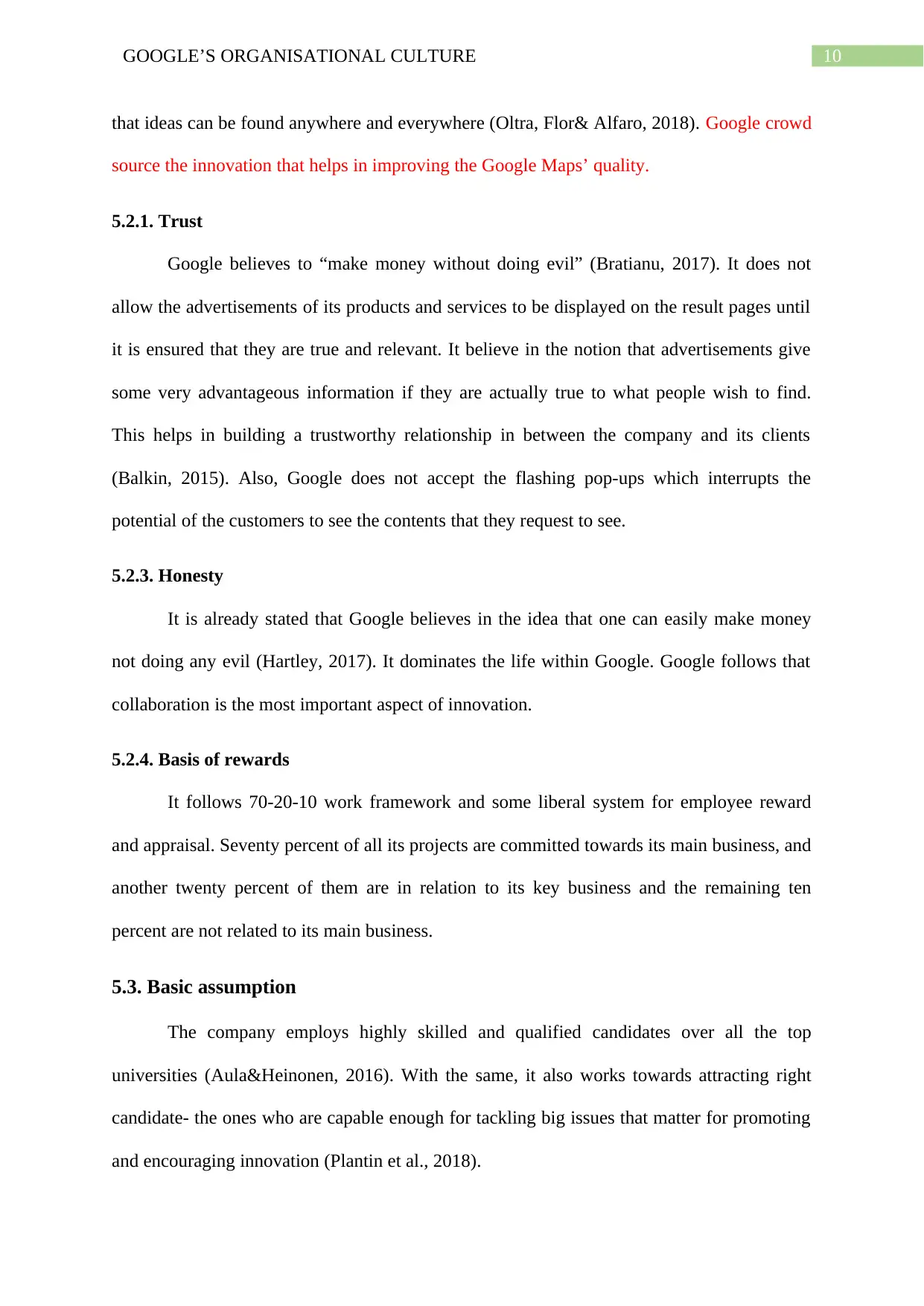
10GOOGLE’S ORGANISATIONAL CULTURE
that ideas can be found anywhere and everywhere (Oltra, Flor& Alfaro, 2018). Google crowd
source the innovation that helps in improving the Google Maps’ quality.
5.2.1. Trust
Google believes to “make money without doing evil” (Bratianu, 2017). It does not
allow the advertisements of its products and services to be displayed on the result pages until
it is ensured that they are true and relevant. It believe in the notion that advertisements give
some very advantageous information if they are actually true to what people wish to find.
This helps in building a trustworthy relationship in between the company and its clients
(Balkin, 2015). Also, Google does not accept the flashing pop-ups which interrupts the
potential of the customers to see the contents that they request to see.
5.2.3. Honesty
It is already stated that Google believes in the idea that one can easily make money
not doing any evil (Hartley, 2017). It dominates the life within Google. Google follows that
collaboration is the most important aspect of innovation.
5.2.4. Basis of rewards
It follows 70-20-10 work framework and some liberal system for employee reward
and appraisal. Seventy percent of all its projects are committed towards its main business, and
another twenty percent of them are in relation to its key business and the remaining ten
percent are not related to its main business.
5.3. Basic assumption
The company employs highly skilled and qualified candidates over all the top
universities (Aula&Heinonen, 2016). With the same, it also works towards attracting right
candidate- the ones who are capable enough for tackling big issues that matter for promoting
and encouraging innovation (Plantin et al., 2018).
that ideas can be found anywhere and everywhere (Oltra, Flor& Alfaro, 2018). Google crowd
source the innovation that helps in improving the Google Maps’ quality.
5.2.1. Trust
Google believes to “make money without doing evil” (Bratianu, 2017). It does not
allow the advertisements of its products and services to be displayed on the result pages until
it is ensured that they are true and relevant. It believe in the notion that advertisements give
some very advantageous information if they are actually true to what people wish to find.
This helps in building a trustworthy relationship in between the company and its clients
(Balkin, 2015). Also, Google does not accept the flashing pop-ups which interrupts the
potential of the customers to see the contents that they request to see.
5.2.3. Honesty
It is already stated that Google believes in the idea that one can easily make money
not doing any evil (Hartley, 2017). It dominates the life within Google. Google follows that
collaboration is the most important aspect of innovation.
5.2.4. Basis of rewards
It follows 70-20-10 work framework and some liberal system for employee reward
and appraisal. Seventy percent of all its projects are committed towards its main business, and
another twenty percent of them are in relation to its key business and the remaining ten
percent are not related to its main business.
5.3. Basic assumption
The company employs highly skilled and qualified candidates over all the top
universities (Aula&Heinonen, 2016). With the same, it also works towards attracting right
candidate- the ones who are capable enough for tackling big issues that matter for promoting
and encouraging innovation (Plantin et al., 2018).
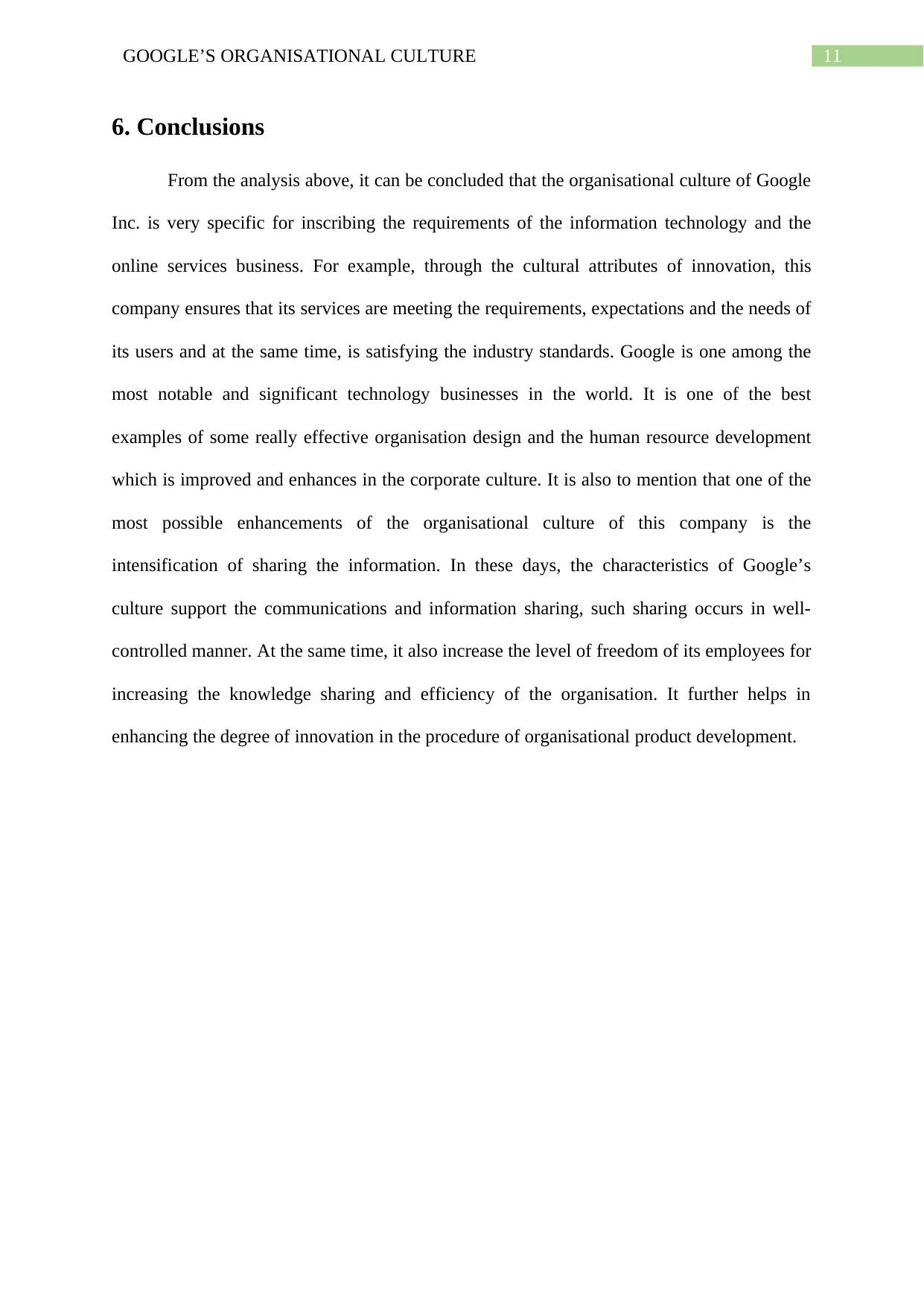
11GOOGLE’S ORGANISATIONAL CULTURE
6. Conclusions
From the analysis above, it can be concluded that the organisational culture of Google
Inc. is very specific for inscribing the requirements of the information technology and the
online services business. For example, through the cultural attributes of innovation, this
company ensures that its services are meeting the requirements, expectations and the needs of
its users and at the same time, is satisfying the industry standards. Google is one among the
most notable and significant technology businesses in the world. It is one of the best
examples of some really effective organisation design and the human resource development
which is improved and enhances in the corporate culture. It is also to mention that one of the
most possible enhancements of the organisational culture of this company is the
intensification of sharing the information. In these days, the characteristics of Google’s
culture support the communications and information sharing, such sharing occurs in well-
controlled manner. At the same time, it also increase the level of freedom of its employees for
increasing the knowledge sharing and efficiency of the organisation. It further helps in
enhancing the degree of innovation in the procedure of organisational product development.
6. Conclusions
From the analysis above, it can be concluded that the organisational culture of Google
Inc. is very specific for inscribing the requirements of the information technology and the
online services business. For example, through the cultural attributes of innovation, this
company ensures that its services are meeting the requirements, expectations and the needs of
its users and at the same time, is satisfying the industry standards. Google is one among the
most notable and significant technology businesses in the world. It is one of the best
examples of some really effective organisation design and the human resource development
which is improved and enhances in the corporate culture. It is also to mention that one of the
most possible enhancements of the organisational culture of this company is the
intensification of sharing the information. In these days, the characteristics of Google’s
culture support the communications and information sharing, such sharing occurs in well-
controlled manner. At the same time, it also increase the level of freedom of its employees for
increasing the knowledge sharing and efficiency of the organisation. It further helps in
enhancing the degree of innovation in the procedure of organisational product development.
⊘ This is a preview!⊘
Do you want full access?
Subscribe today to unlock all pages.

Trusted by 1+ million students worldwide
1 out of 17
Related Documents
Your All-in-One AI-Powered Toolkit for Academic Success.
+13062052269
info@desklib.com
Available 24*7 on WhatsApp / Email
![[object Object]](/_next/static/media/star-bottom.7253800d.svg)
Unlock your academic potential
Copyright © 2020–2025 A2Z Services. All Rights Reserved. Developed and managed by ZUCOL.





